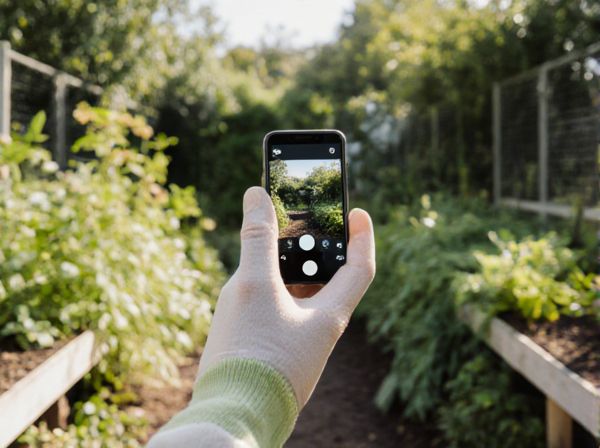
Keyhole Garden vs Traditional Raised Bed Illustration
Keyhole gardens maximize space and water efficiency with a central composting basket that nourishes plants evenly, making them ideal for small yards or drought-prone areas. Traditional raised beds offer straightforward construction and flexibility in size and shape, suitable for growing a wide variety of crops with easier access for maintenance. Both methods improve soil quality and drainage but differ in resource management and design complexity.
Table of Comparison
| Feature | Keyhole Garden | Traditional Raised Bed |
|---|---|---|
| Design | Circular with central composting basket | Rectangular or square bed, no compost integration |
| Water Efficiency | High - compost basket retains moisture | Moderate - requires regular watering |
| Space Utilization | Compact, maximizes planting area | Depends on bed size and layout |
| Soil Fertility | Self-fertilizing via composting | Depends on added amendments |
| Setup Complexity | Moderate - requires building compost basket | Simple - basic frame and soil fill |
| Maintenance | Low - minimal watering, nutrient replenishment | Higher - frequent watering and fertilizing |
| Ideal Use | Water-scarce areas, nutrient recycling | General gardening, flexible bed placement |
Introduction to Keyhole and Traditional Raised Beds
Keyhole gardens feature a circular design with a central composting basket that efficiently recycles organic waste and water, enhancing soil fertility and moisture retention. Traditional raised beds are rectangular or square frames filled with nutrient-rich soil, designed to improve drainage, reduce soil compaction, and extend the growing season. Both gardening methods optimize space and soil quality, but keyhole gardens emphasize sustainability and resource conservation through their innovative structure.
Design Concepts: Keyhole vs. Traditional Raised Beds
Keyhole gardens feature a circular design with a central composting basket that efficiently delivers nutrients and water to plants, maximizing resource use and minimizing waste. Traditional raised beds are typically rectangular or square, emphasizing easy access and soil customization but relying on external watering and fertilization methods. The keyhole design integrates sustainability and self-sufficiency, while traditional raised beds prioritize simplicity and modularity for diverse gardening needs.
Materials and Construction Differences
Keyhole gardens utilize a central composting basket made from natural materials like bamboo or wire mesh, which enriches soil fertility through continuous organic matter breakdown, unlike traditional raised beds built with solid wooden planks or stone. Construction of keyhole gardens involves a circular, inwardly curved design that maximizes access to the compost and water retention, while traditional raised beds typically feature rectangular frames for straightforward planting and maintenance. The use of recycled or locally sourced materials in keyhole gardens supports sustainability, contrasting with the often commercially purchased lumber or treated wood in conventional raised beds.
Soil Composition and Watering Techniques
Keyhole gardens feature a nutrient-rich soil composition with layers of organic matter, compost, and mulch designed to retain moisture and improve fertility, while traditional raised beds typically use a uniform soil mix optimized for drainage and aeration. Watering in keyhole gardens is concentrated around a central well, promoting efficient water distribution and minimizing evaporation, whereas traditional raised beds often rely on surface watering or drip irrigation systems. The integration of compost in the central basket of keyhole gardens enhances soil microbial activity, contrasting with the more passive soil enrichment methods in traditional raised beds.
Space Efficiency and Layout
Keyhole gardens maximize space efficiency by incorporating a circular design with a central composting basket, allowing easy access to plants and optimal nutrient recycling within a compact footprint. Traditional raised beds typically use rectangular layouts, requiring more space for pathways and limiting planting density. The unique keyhole layout enhances water retention and soil health, making it ideal for small or irregular spaces compared to conventional raised beds.
Composting Integration in Keyhole Beds
Keyhole gardens feature a built-in composting basket at their center, allowing organic waste to decompose directly adjacent to plant roots, enhancing nutrient delivery and soil fertility. Traditional raised beds typically require separate composting systems, which can limit nutrient efficiency and increase maintenance efforts. The integration of composting in keyhole beds improves water retention and microbial activity, promoting healthier plant growth and sustainable gardening practices.
Accessibility and Ergonomics
Keyhole gardens offer superior accessibility by incorporating a central composting basket, allowing gardeners to easily reach all planting areas without bending or stretching. Traditional raised beds, while elevated, often require gardeners to walk around and lean over edges, which can strain the back and knees. Ergonomically, keyhole designs reduce physical effort and improve comfort by minimizing repetitive movements, making them ideal for elderly or mobility-impaired gardeners.
Suitability for Different Climates
Keyhole gardens excel in arid and semi-arid climates due to their water-efficient design, incorporating a central composting basket that retains moisture and enhances soil fertility. Traditional raised beds perform well in temperate and humid climates where consistent rainfall supports crop growth without intensive irrigation. Gardeners should consider local precipitation patterns and water availability when choosing between keyhole gardens and traditional raised beds to maximize yield and resource efficiency.
Crop Variety and Yield Potential
Keyhole gardens maximize crop variety and yield potential by integrating composting within the bed, enhancing soil fertility and moisture retention for diverse plant growth. Traditional raised beds, while effective for standard crop cultivation, often require more frequent watering and fertilization, limiting their efficiency in producing high yields of varied crops. The circular design of keyhole gardens promotes space efficiency and continuous nutrient cycling, resulting in improved productivity compared to conventional linear raised beds.
Maintenance and Long-Term Sustainability
Keyhole gardens require less frequent watering and maintenance due to their efficient water retention and nutrient recycling system, promoting long-term sustainability with minimal resource input. In contrast, traditional raised beds often demand regular watering, soil amendment, and weeding to maintain productivity, increasing labor and resource needs over time. Sustainable gardening benefits from the self-fertilizing, compost-integrated design of keyhole gardens, which supports healthier soil ecosystems and reduces external inputs compared to conventional raised beds.
Keyhole Garden vs Traditional Raised Bed Infographic

 gardendif.com
gardendif.com